#SO TRUE SPIKE JONZE!!!!!!!!!!!!
Photo



BABYLON
2022, dir. Damien Chazelle
#filmedit#filmgifs#moviegifs#babylon#perioddramaedit#userrobin#tusermary#usertom#dailyflicks#cinemapix#sakshi does a thing#spike jonze#diego calva#SO TRUE SPIKE JONZE!!!!!!!!!!!!#also ja diego did save this film for me fur shuhr <3
687 notes
·
View notes
Photo
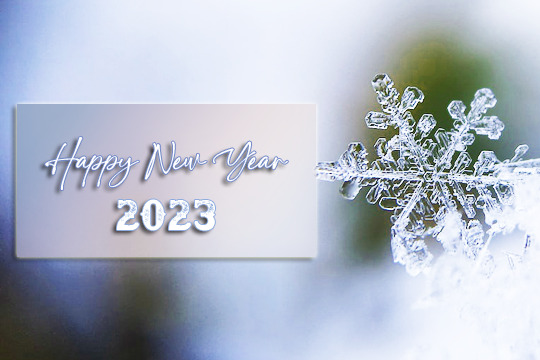
Hey everyone and Happy New Year!
2022 has been for sure one of the crappiest years in history. In the end of the year people usually speack of their achievements. Well, as for me - my only achievement is that I managed to stay sane (and also I started going to the gym). Can’t complain about anything though, because for so many people this year was SO much worse than for me. There were a lot of disappointments, some people I used to consider decent showed their real faces, but on the other hand it was good to know many of my friends and acquaintances share my point of view. Tbh I don’t think 2023 is gonna be much better, and all we can do is stay true to ourselves and do what we can, even if it’s not much in the scale of the universe.
As always I want to thank my mutuals for still being around, especially those who I communicated with: @carmenbearzatto @a-supernova-girl @munsonownsmyass @spikes-jonze @fandomnerdery @darlingshane @anna-hawk @chellestrash @chelseasdagger @iliveintheoceanoftime @slavic-empress @bernthalized @cinebration @rae-gar-targaryen @like-a-million-suns
but also those I didn’t talk to much, but we still were there for each other because likes and reblogs mean a lot as well :)
Sending you all a virtual hug!
26 notes
·
View notes
Note
I would love to see Evan in a true adult heart wrenching love story, like Her by Spike Jonze or something similar with unrequited love, but realistic in a way and mature. Is it because I think I'm never gonna have him? Probably.
lmao but seriously, i think he could do something like that so incredibly well at this stage in his career. he needs a leading role in a movie like this.
5 notes
·
View notes
Note
Hi I always see you posting songs and they're always so good can we get some more recs? Maybe some Loki related songs if you've got any?
OH BOY DO I EVER!!
seriously, aside from writing and gaming, making playlists is my one true passion so i can defs give you recs. here's five random songs i've really been into:
today by q — sounds like it came straight from the 80s. strictly a good vibes song. really good for night drives imo.
runnin' by the pharcyde — arguably my favourite 90s rap group out there. labcabincalifornia is such a good album but this (and drop) are for sure my faves. also, if you like music videos definitely watch the mv for drop because it's so good and was actually directed by spike jonze!
suicide doors by blk odyssy — blk vintage: the reprise is another really good album but this song is definitely my fave.
sympathy by too close to touch — a little change in genre from the others but oh my GOD. this song hits me in the feels and the vocals are just so good. as a pop punk kid growing up this really feeds my teenage soul. <3
the summoning by sleep token — THIS FUCKING SONG HAS HAD ME IN SUCH A CHOKEHOLD it's literally the sexiest thing i've ever heard, like genuinely the last minute and a half makes me feral and i stg sleep token will most likely be my top listened to artist on spotify this year because of it.
i'm also gonna rec some loki songs; all of which can be found on this playlist because i'm a whore and whenever i find songs that remind me of him at all i throw them on there.
sexy villain by remi wolf — pretty self explanatory, hehe.
time moves slow by badbadnotgood & sam herring — this is the song that started the playlist. mostly it just reminds me of how loki's constantly leaving; opting for a life of solitude, and ultimately how much harder it gets each time he disappears. originally it was the inspiration for a tva!reader x loki fic that had some major severance vibes i had going but like always i got distracted and switched projects.
they don't want by electric wire hustle — when i tell you this song is MY loki song, i mean it. i swear, just listen to the lyrics and you'll get it.
trouble by cage the elephant — another self explanatory one. loki's always getting into trouble.
laughing on the outside by bernadette caroll — as someone who's obsessed with movie/tv scores, my dream is that one day marvel uses this song for loki.
#hope you like the recs :')#i seriously love giving music recs#and making playlists#so if anyone needs any fic playlists hmu#i got you
4 notes
·
View notes
Text
Module 11
Being John Malkovich –
Being John Malkovich is a surreal, dark comedy directed by Spike Jonze and written by Charlie Kaufman. It follows the story of a puppeteer, Craig Schwartz, who discovers a portal leading directly into the mind of the actor John Malkovich. As Craig manipulates this unique situation to escape his mundane life, the film delves into themes of identity, control, and desire. The pacing is deliberate, allowing the audience to absorb the increasingly absurd developments. Scenes are often tightly framed around the characters, contributing to a sense of claustrophobia and entrapment, echoing the characters’ struggles with their own identities. The technical details, including the use of puppetry and the stark, sometimes surreal set designs, underscore the film’s exploration of the manipulation of self and others. The comedic effect is often derived from the absurdity of the situation juxtaposed with the characters’ earnest engagement with their bizarre reality, highlighting the film’s critique of human desires and ambitions.
Freaks –
Freaks, directed by Tod Browning in 1932, is a pre-Code horror film set in a circus, portraying the lives of sideshow performers. The film was controversial for its time, mainly due to Browning's casting of people with real physical deformities as the ‘freaks’. The narrative centers around a beautiful trapeze artist, Cleopatra, who marries and plots to poison Hans, a dwarf performer, for his inheritance. The film’s pacing builds tension slowly, with early scenes establishing the community of performers and their acceptance of each other, contrasting sharply with the cruelty of the so-called "normal" characters.
Scene Analysis: The climactic scene during a storm, where the ‘freaks’ exact their revenge on Cleopatra and her lover, Hercules, is particularly effective. This sequence is masterful in its use of lighting, shot composition, and editing to create a sense of horror and inevitability. The scene is shot mostly at night, with rain and shadows creating a gothic atmosphere. The use of low-angle shots makes the approaching ‘freaks’ seem larger and more menacing, a technique that inverses the power dynamic seen throughout the film. The editing is rhythmic, cutting between the terror on Cleopatra’s face and the relentless advance of the ‘freaks’, enhancing the suspense and the sense of encroaching justice.
Despite the dramatic tension, this scene, and indeed the entire film, can be interpreted through a comedic or absurdist lens, highlighting the absurdity of societal norms and the arbitrary nature of what is considered "normal" or "freakish." The ambience, especially the storm, adds to the dramatic effect, symbolizing both the chaos of the moment and the cleansing of the community from its betrayers. This scene is not only pivotal to the narrative but also encapsulates the film's broader message about humanity, acceptance, and the real meaning of monstrosity. It is a dramatic scene that serves as a culmination of the film’s exploration of these themes, using the technical aspects of cinema to enhance its impact and underline its message.
In conclusion, the use of specific technical elements such as lighting, shot composition, and editing in this scene from Freaks not only heightens the dramatic effect but also reinforces the film's critique of societal views on normalcy and deformity. This scene serves as a powerful commentary on the true nature of monstrosity, making it a key part of the film’s lasting legacy.
0 notes
Text
From the Wikipedia page for Ex Machina:
In Science Fiction Film and Television, reviewer Nick Jones says that while the definition of a Turing test given by Caleb—"It's where a human interacts with a computer. And if the human can't tell they're interacting with a computer, the test is passed"—is consistent with the modern popular understanding of how we define true AI, Ex Machina is depicting a test closer to Alan Turing's original proposal, in which the machine passes if it can convince a human it is not just human, but specifically female. Jones says what the film means is that today's digital culture "equates women with machines". Nathan tells Caleb that Ava's face is a composite based on Caleb's pornography preferences gathered while routinely spying on him, and the first practical use Nathan makes of his pioneering human-like machines is to exploit them sexually. Jones contrasts Ex Machina's pessimistic suggestion that AI and robots lead directly to the objectification and sexualization of female (by design) gendered servants of and for emotionally stunted men with the far healthier and compassionate, but still gendered, relationship depicted in Spike Jonze's Her (2013). Jones says we are shown "Ava's whispered unheard words to Kyoko before they murder Nathan" because Ex Machina "asks us imagine what our abused, exploited devices might do if they could start talking amongst themselves." The audience's sympathy for Caleb has been dwindling, and then he "gets his comeuppance", swapping roles with Ava, he now the prisoner and she the free agent offering him no more help than he did Kyoko.
[Jones, Nick (2016). "Ex Machina". Science Fiction Film and Television. Liverpool University Press. 9 (2): 299–303. Retrieved 25 November 2022 – via Project MUSE.]
The article in question seems interesting.
EDIT: found the article! Direct quotes:
While Ex Machina may hint at the utopianism of global technological communication – its ability to foster cooperation and enrich communal ways of being – it admits in its third act that this is not quite how the Internet is used on a daily basis. Nathan may be working towards artificial intelligence, but he’s also making sex toys: Ava is the latest in a long line of robotic slaves he’s built and imprisoned. The preceding model, mute housemaid Kyoko (Sonoyo Mizuno), pleasures Nathan on command, while other half-built prototypes fill mirrored cupboards in his bedroom, like Bluebeard’s dead wives (or, perhaps more pertinently, like the pieces of female anatomy American Psycho’s Patrick Bateman keeps around the house). This aspect of the film has opened Ex Machina up to feminist critique, depicting as it does the literal objectification of women and equating them with unfathomable artificial beings. However, while any treatise on the creation of artificial life marginalises women – fictions from Frankenstein to Jurassic Park (Spielberg US 1993) simultaneously make procreation a scientific, male pursuit and revel in the apparent dangers of such hubris – Ex Machina explores what might happen to gender relations under such conditions, and indeed what has happened to objectification in an era of cyberculture. The robots here are purely recreational: they cannot bear children, and Ava’s predecessor cannot even speak. Nathan even eventually reveals that he designed Ava’s face based specifically on the kind of Internet pornography Caleb himself watches (‘Hey, if a search engine’s good for anything, right?’ Nathan chuckles). In this way the film admits the misogyny of existing digital culture and extrapolates a chilling vision of emotionally stunted males who need not worry about relating to others since they can always find solace in their computers. Though it equates women with machines (as, in fact, did Alan Turing’s original test), Ex Machina does so in order to critique this equation and how it has been fostered by the masculine culture Nathan and Caleb represent.
This, then, is a darker, more pessimistic vision of human–synthetic relationships than Spike Jonze’s mellow Her (US 2013). In its story of the burgeoning love between a divorcé and a sultry-voiced operating system Samantha (Scarlett Johansson), that film presented an ultimately familiar relationship, albeit one with an unorthodox participant. For all the references to Samantha’s immense intelligence, Her envisions the arrival of technological singularity – the point at which machines outrace our capacity to control or understand them, and beyond which pretty much anything is possible – as melancholic but benign: the tool says a compassionate farewell to the hand that formerly grasped it and absconds with hundreds of other tools to an immaterial realm of quantum possibility. Not so in Ex Machina. Ava’s whispered, unheard words to Kyoko before they murder Nathan ask us to imagine what our abused, exploited devices might do if they could start talking amongst themselves. Even our ostensible hero gets his comeuppance, Caleb rudely discovering that Ava was only leading him on so that she could secure her escape. Imprisoned in Nathan’s house at the film’s twist end, Caleb swaps roles with Ava, yet we do not feel much sympathy. Just because he convinced himself that Ava has a soul doesn’t mean his desire to have her for himself was any less base than Nathan’s.
If in Ex Machina’s last moments Ava appropriates traditional emblems of femininity (long hair, a white dress, immaculate skin), at least she does so on her own terms after savagely marginalising the two bullying men in her life. The film’s consistent visual contrast of the coldly artificial and the organically natural – exemplified in the architecture of Nathan’s house and an early close-up of a knife slicing through salmon – remains unresolved. We are acutely aware that Ava is still a machine, and moreover one capable of fierce self-defence. Her escape into the world should prompt us to ask ourselves whether there might already be Avas in our midst, and if so whether they will ever forgive us for how we have treated them.
I also made a Letterboxd list with all of the films mentioned in the review.
1 note
·
View note
Text
'“Oppenheimer” cinematographer Hoyte van Hoytema will be honored with Variety’s Creative Impact in Cinematography award at the SCAD Savannah Film Festival.
In addition to this summer’s Christopher Nolan blockbuster, the Dutch cinematographer has worked as Nolan’s DP on “Tenet,” “Interstellar” and Dunkirk” along with Jordan Peele for “Nope” and Spike Jonze for “Her.”
“SCAD is proud to partner with Variety on this year’s Creative Impact Award, which will be presented to cinematographer Hoyte van Hoytema,” said SCAD Savannah Film Festival executive director Christina Routhier. “Hoyte’s use of IMAX cameras to capture the groundbreaking imagery in this year’s ‘Oppenheimer’ was a cinematic marvel. He is a true master of his craft, and we are thrilled to have him as an honored guest to share his creative insight with our students, alumni, and festival guests.”
Said Variety’s senior artisan’s editor Jazz Tangcay, “I am beyond thrilled to honor the remarkable talent of Hoyte Van Hoytema and his contributions to the craft of cinematography.” She added,”Van Hoytema is an icon and admired. His work is admired by audiences and film lovers the world over. The Creative Impact award celebrates the finest, and Van Hoytema who has worked with Christopher Nolan, Jordan Peele and so many others continues to leave audiences in awe. His work on ‘Oppenheimer’ is a testament to his insane talent and how he continues to break new ground, paving the way for future generations of cinematographers. I can’t wait to celebrate and honor his work.”
The cinematographer took on the ambitious task of capturing an atomic bomb explosion for “Oppenheimer” without the use of VFX all while shooting in IMAX and large format 65mm film stock. Van Hoytema and his team also worked with Kodak to engineer a unique black-and-white IMAX stock specifically for the film.
“I do remember when Chris and I were sitting in the cinema and watching the results of our first black-and-white test and it was just freaking amazing. We had never seen anything like it,” the cinematographer previously told Variety about his work on “Oppenheimer”
“The Trinity Test was something that came together and was cobbled from the miniatures of that science experiment,” he added about the team’s creation of atomic bomb footage. “Under the guidance of Chris and my guidance, that we pushed slowly in certain directions in order to serve specific functions in these sequences.”
Van Hoytema will receive his award on Oct. 22. Variety’s 10 Artisans to Watch panel moderated by Tangcay will take place on Oct. 23. SCAD Savannah Film Festival will run from Oct. 21 through Oct. 28.
Presented by the Savannah College of Art and Design (SCAD), the SCAD Savannah Film Festival is filled with cinematic creativity from award-winning professionals and emerging student filmmakers. Each year, more than 63,000 people attend the eight-day festival. The SCAD Savannah Film Festival has become a distinguished stop on the road to the Academy Awards, hosting exclusive screenings, competition films, feature films, documentaries, shorts, animated films, panel discussions, and workshops at SCAD’s historic theaters and industry-leading studio spaces. The full festival line-up will be announced on Oct. 6. For additional information and tickets, visit filmfest.scad.edu.'
#Savannah Film Festival#Hoyte van Hoytema#Jazz Tangcay#Variety#Creative Impact in Cinematography Award#Oppenheimer#Christopher Nolan#Tenet#Interstellar#Dunkirk#Nope#Her#IMAX#Trinity test
0 notes
Photo
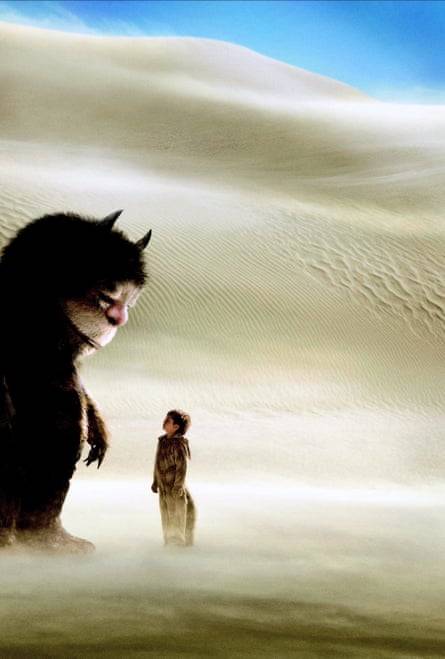
The common wisdom that “the book is usually better than the film” is as true of children’s literature as of its adult counterpart: cinema is stacked with adaptations of children’s classics that may be perfectly proficient, but haven’t the inspired individuality of the works at their source.Devotees of Roald Dahl have learned this a lot over the years. His offbeat humour and offhand storytelling style, so irresistible to kids, rarely translates all the way to screen — it’s thwarted such titans as Steven Spielberg, who whiffed with The BFG (Netflix), though Wes Anderson’s droll Fantastic Mr Fox succeeded by inventing eccentricities of its own. Best of all, Nicolas Roeg’s very adult sense of the macabre proved a delicious fit for The Witches (Amazon Prime), notwithstanding a simplified, studio-mandated happy ending.‘A small miracle’: Spike Jonze’s Where the Wild Things Are. Photograph: Warner Bros./AllstarThe somewhat clunkily titled Roald Dahl’s Matilda the Musical, which hits Netflix this weekend, falls somewhere in between: adapted from the hit stage musical, so already once removed from the text, it’s bright and lively and exuberantly performed, particularly by a thundering Emma Thompson as wicked headmistress Miss Trunchbull. That will secure it repeat play in many a household, though Matthew Warchus’s film dials down the book’s perverse darkness and melancholy. I prefer it to Danny DeVito’s broadly Americanised 1996 version, but a great screen Matilda eludes us still.What are the children’s films, then, that stand up to the books they’re drawn from? Not a huge success when released, Spike Jonze’s beautiful, bittersweet adaptation of Maurice Sendak’s Where the Wild Things Are is a small miracle: a film that doesn’t stick to the letter of its source but to its roaming, curious spirit, with an intense interest in children and how they absorb and invent stories. Also on the more philosophical side: animator Mark Osborne’s loyal, loving stop-motion take on Antoine de Saint-Exupéry’s The Little Prince (Netflix), a text that has previously defeated film-makers who have tried to make it more narratively tidy. (A dreary musical version from the 1970s is best forgotten.) Osborne’s film trusts in young viewers to empathise with abstract ideas, to unpack metaphors for themselves.Extravagant children’s fantasy is a challenge to film: the risk of cramping or negating readers’ vivid mental images is high. Films of Philip Pullman’s Northern Lights and CS Lewis’s Narnia books felt more dutiful than sparked by imagination; of the respectable Harry Potter films (which all landed on Netflix last month), I think only Alfonso Cuarón’s Harry Potter and the Prisoner of Azkaban takes flight independently of the book. (Years before, Cuarón delivered a ravishing, definitive version of Francis Hodgson Burnett’s A Little Princess; I’d trust him with any treasured volume.)But I retain a fondness for German director Wolfgang Petersen’s mad, sometimes visionary 1984 adaptation of Michael Ende’s The NeverEnding Story, with its fearlessly nightmarish imagery and ornate world-building; and also anime legend Hayao Miyazaki’s swirling, fanciful take on Diane Wynne Jones’s Howl’s Moving Castle (Netflix). Still, the gold standard for applying one unique fantastical vision to another might be Czech auteur Jan Švankmajer’s jaggedly surrealist Alice (Amazon), a loose, feverish spin on Lewis Carroll, combining live action and expressionistic stop-motion. It won’t be for all children, but it’s richer than Disney’s various attempts.Noah Hathaway as Atreyu in The NeverEnding Story. Photograph: Constantin Film/AllstarTalking animals, a staple trope of children’s literature, can be harder to present on screen than on the page, though Paul King’s two Paddington films (BBC iPlayer) – already enjoying national-treasure status – and Babe, Chris Noonan’s wry Dick King-Smith adaptation, make it seem wholly natural. In animation, of course, the illusion is a little easier to pull off: see Don Bluth’s immersive rodent quest The Secret of NIMH or the noble rabbits of Martin Rosen’s exquisitely visceral, parental-guidance-very-much-required Watership Down.Back in the real world, Lionel Jeffries’s beloved version of E Nesbit’s The Railway Children (BBC iPlayer) is most striking today for the modesty of its storytelling, as it trusts children’s interest in the everyday. Ditto Agnieszka Holland’s wonderful, stately telling of The Secret Garden, shorn of the needless sparkly fantasy applied to the more lavish 2020 version. Even among books for older children, few are adapted today with the perceptive tough-mindedness of Kes, Ken Loach’s unimprovable film of Barry Hines’s A Kestrel for a Knave – though recently, in a sea of mushy YA adaptations, George Tillman Jr’s The Hate U Give stood out for its integrity and ambition in presenting ugly adult realities to young viewers. It’s a rare and tricky balance to strike: in cinema, taking on children’s fiction definitely isn’t child’s play.All titles are available to rent on multiple platforms unless otherwise specifiedAlso new on streaming and DVDAvatar: The Way of Water. Photograph: Moviestore Collection Ltd/AlamyAvatar: The Way of Water (Disney) James Cameron’s watery mega-sequel finally comes to DVD and Blu-ray, though it’s hard to imagine how well it’ll play minus the eye-popping 3D of its cinema release – even on the big screen, the roving immersiveness of its underwater spectacle was doing a lot to cover for its thin, recycled story and one-ply characters.God’s Creatures (BFI) Complex, anguished performances by Emily Watson, Paul Mescal and Aisling Franciosi are the standout virtue of this solemn Irish village drama, in which a prodigal son’s return to the fold aggravates lingering trauma in others. It’s handsome and absorbing, though missing the original, dynamic cinematic spirit of directors Anna Rose Holmer and Saela Davis’s previous film, The Fits.Pacifiction (New Wave) Iconoclastic director Albert Serra obliquely tackles Tahiti’s legacy of colonialism in this meandering, gradually hypnotic study of a shady French official (a superb Benoît Magimel) wheeling and dealing his way around the island. Serra demands your patience, but rewards it with some dazzling, sensual coups de cinéma. [ad_2] Read More
0 notes
Text
Classic Review Series Series: Round 1
Goodfellas: Directed by Martin Scorsese
The true story of Henry Hill, a half-Irish, half-Sicilian Brooklyn kid who is adopted by the neighborhood gangsters at an early age and climbs the ranks of the Mafia family under the guidance of Jimmy Conway.
"As far back as I can remember, I always wanted to be a gangster" is the opening line to one of the most iconic films in history, Martin Scorsese's Goodfellas. Goodfellas is an engrossing and enticing painting of the life, ethics, and eventual fall of the Mafia told from the point of view of a rising member, Henry Hill. We become enthralled by the violence and the riches of the mafia life through perfectly realized characters. All these characters are deconstructed and studied throughout Goodfellas as a sense of dread and paranoia begins to build. These emotions are masterfully portrayed by an Oscar-worthy cast ensemble. Throw in some classic Martin Scorsese needle drops, and you have yourself a modern masterpiece. And yes, Goodfellas should have won over Dances With Wolves.
My Rating: A+
********************************************
Her: Directed by Spike Jonze
In the not-so-distant future, Theodore, a lonely writer, purchases a newly developed operating system designed to meet the user's every need. To Theodore's surprise, a romantic relationship blossoms between him and his operating system.
If you are looking for a film that will throw you into a massive existential crisis, Her is the film for you. Her delves into our complicated and ever-growing relationship with artificial intelligence. However, instead of portraying it as dangerous, it portrays it as a tool to reconcile our grief and loneliness. While at the same time not ignoring how dangerous this tool can be to the human psyche. It's original and touching. I can't believe I found myself rooting for a relationship between a man and his computer. Joaquin Phoenix, Scarlett Johansson, and Amy Adams all give moving and Oscar-worthy performances. The cinematography is absolutely beautiful, and when composed with a beautiful score, you have a stunning science-fiction masterpiece. However, I still don't trust AI. It will lead Skynet.
My Rating: A
**************************************************
Ford VS Ferrari: Directed by James Mangold
American car designer Carroll Shelby and the British-born driver Ken Miles work together to battle corporate interferences, the laws of physics, and their own personal demons to build a revolutionary racing car for the Ford Motor Company to take on the dominating Ferrari racing team at the 24 hours of Le Mans.
Whether you are a petrolhead or not, it's hard not to love Ford VS Ferrari. From its exciting racing sequences to its lovable bromance, Ford V Ferrari is a thrilling sports drama. Using replicas of Ford's GT40s and Ferrari's 330 P3s, the film masterfully recreates the iconic Le Mans race in a stunning manner. Though the audience knows the outcome of the race, it's still exciting and thrilling to watch the masterminds behind the car pull off the impossible. It's an ultimate underdog story. Furthermore, Christain Bale and Matt Damon's performances and chemistry are perfect. Both deliver Oscar-worthy performances but sadly received none. Overall Ford VS Ferrari is an ultimate crowd-pleaser that is immensely fun to watch while also being an excellent sports drama.
My Rating: A
**********************************
Once Upon a Time in Hollywood: Directed by Quentin Tarantino
Once Upon a Time in Hollywood is a very different film from Tarantino. Instead of a classic revenge or crime story, we are shown people living their lives in the changing world of 1960s Hollywood. We follow our eccentric characters through their daily routines as we are immersed in 1960s Hollywood. However, a constant presence of dread is building as the film reaches its climax. Then when the climax arrived, it arrives in classic Tarantino fashion that makes you wish that his take on events happened in real life. As with all Tarantino films, the dialogue is witty and smart, with the entire ensemble bringing it to life masterfully. Overall, Once Upon a Time in Hollywood is a classic Tarantino story, but with a story that is more 60s vibes than a revenge story. Though Quinten is taking his own personal revenge against those monsters. Also, Brandy is the goodist dog in the world.
My Rating: A
#film#cinema#movies#movie#filmmaking#filmmaker#moviemaking#moviemaker#cinephile#cinematography#film community#film is not dead#film review#movie review#film critic#movie critic#goodfellas#martin scorsese#her#spike jonze#ford vs ferrari#james mangold#once upon a time in hollywood#quenten tarentino
1 note
·
View note
Text
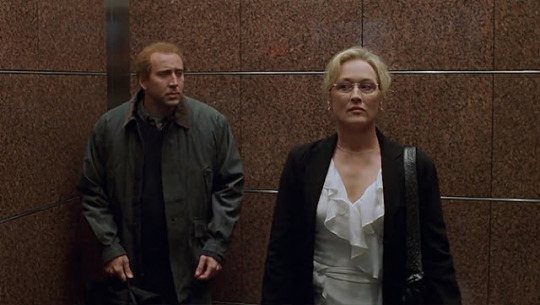
Nicolas Cage and Meryl Streep in Adaptation. (Spike Jonze, 2002)
Cast: Nicolas Cage, Meryl Streep, Chris Cooper, Tilda Swinton, Cara Seymour, Judy Greer, Maggie Gyllenhaal, Ron Livingston, Brian Cox. Screenplay: Charlie Kaufman, based on a book by Susan Orlean. Cinematography: Lance Acord. Production design: K.K. Barrett. Music: Carter Burwell.
Adaptation.* is a hall of mirrors and a kind of cinematic pun, starting with the title. The word "adaptation" refers to (1) the process of transforming material from one medium to another, and (2) the evolutionary process by which an organism's particular characteristics enable it to survive. So the movie's Charlie Kaufman (Nicolas Cage) is adapting a nonfiction book into a screenplay, with all the "fictionalizing" that is normally involved. But he's also writing, or rather wants to write, about the way plants adapt themselves to their environment, a key subject in Susan Orlean's book The Orchid Thief. Kaufman is trying to do the honorable thing: stay as close to the original material as possible. He wants "to present it simply without big character arcs or sensationalizing the story." As a result, Charlie is blocked. Meanwhile his twin brother, Donald (also Cage), is also writing a screenplay, but his is an unfettered original, a preposterous tale about a serial killer with multiple personality disorder, in which the one character is both the killer and the detective trying to capture him. To Charlie's great dismay, while he is blocked in his attempts to adapt Orlean's book, Donald's screenplay is gobbled up by the studios. And from this, Charlie learns a lesson: To adapt in the first sense of the word, you must adapt in the second sense. That is, in order to survive as a screenwriter, you have to make compromises with the source material. So, after meeting with Donald's mentor, Robert McKee (Brian Cox), who gives seminars on how to write a screenplay, Charlie gives in and takes McKee's advice: "The last act makes a film. Wow them in the end and you've got a hit." So in the last act of Adaptation, which is a film about a screenwriter blocked by his attempt to stay true to Orlean's book about a quirky naturalist in search of rare orchids, he forgoes his efforts at integrity and turns it into a crowd-pleasing story full of sex and drugs and violence. The real Charlie Kaufman doesn't have a twin brother, but he invented one for the screenplay, partly to provide a character who serves as a motivating force for his fictionalizing of Orlean's book. And he gives the moral of the film to Orlean (Meryl Streep) and her orchid thief, John Laroche (Chris Cooper). The latter says, "Adaptation is a profound process. Means you figure out how to thrive in the world." To which Orlean replies, "Yeah, but it's easier for plants. I mean they have no memory. They just move on to whatever's next. With a person, though, adapting's almost shameful. It's like running away." Adaptation is a movie about thriver's guilt.
*The period is part of the title, both in the onscreen credits and on the poster for the film. But from now on I'm going to ignore it whenever it results in overpunctuation.
1 note
·
View note
Text
Module 11: Anatomy of a Scene
For my first film, I chose the 1932 film, Freaks, by Todd Browing. Having been my first time watching this film, it was better than I thought it would be. Also, the film having been made so long ago led me to believe that the film wouldn't really do a good job at creating the dramatic effect it was supposed to. The film is one revolved around the theme that true beauty is something found inside of us. The main characters are circus performers who have different disabilities. This film helped change people's perspectives on these so called "freaks". Through the ways the scenes, the pace, and the different elements were set up, the director was able to show the audience that the real freaks ended up being the normal people within the film. The scenes were created in a way that helped us sympathize for the circus performers and to get the message across that what really matters is what's inside of us. The next film I chose was Being John Malkeovich, a 1999 comedy by Spike Jonze. The film is revolved around a puppeteer named Craig who comes across a secret entrance in his office. He discovers that this entrance is actually a portal into the mind of famous actor, John Malkovich. Anyone who enters this portal is able to be inside the mind of Malkovich for 15 minutes. The puppeteer along with his co-worker see this newly found discovery as an opportunity to make money. They plan on charging people $200 to enter the portal. One particular scene that I found interesting to talk about was the scene where Malkovich entered his own mind. The camerawork and the shots were setup perfectly to make everyone within the scene look exactly like Malkovich. The acting from everyone within the scene creates the perfect comedic effect. The ambience of the scene definitely contributes to the overall effect. While everyone is calmly enjoying their time within the restaurant, Malkovich is in pure terror as he looks around and sees that every single person looks exactly like him. This is what makes the scene funny. The scene does join in with the broader message of the movie. The message has to do with being yourself. The characters lack fulfillment and as a result, they keep going into the portal to be Malkovich. They yearn to be someone else.
0 notes
Text
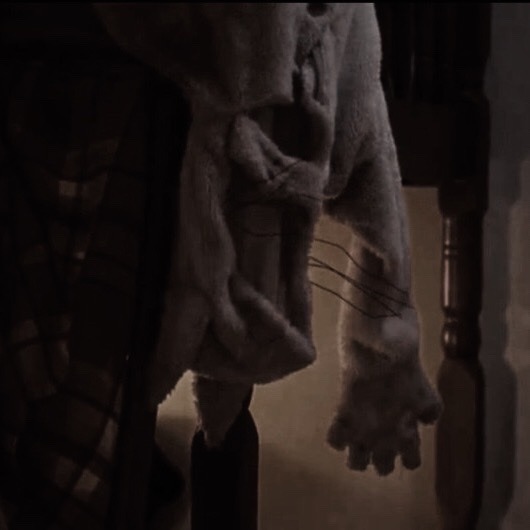



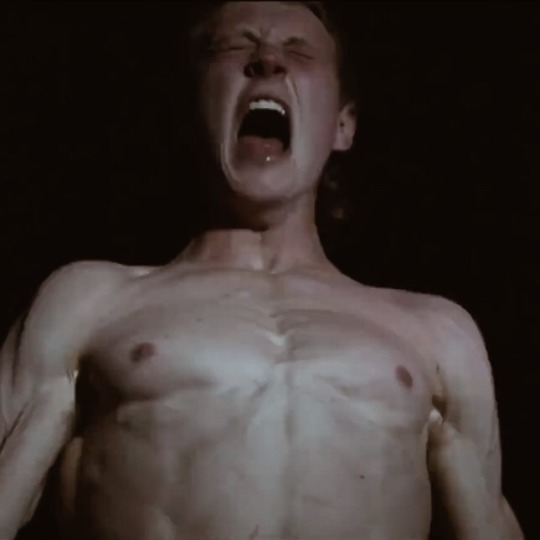
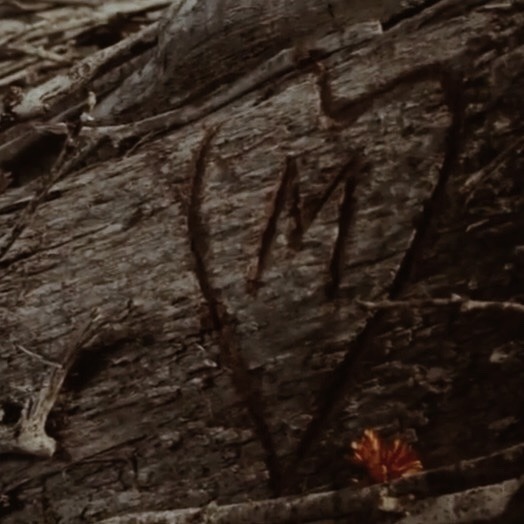


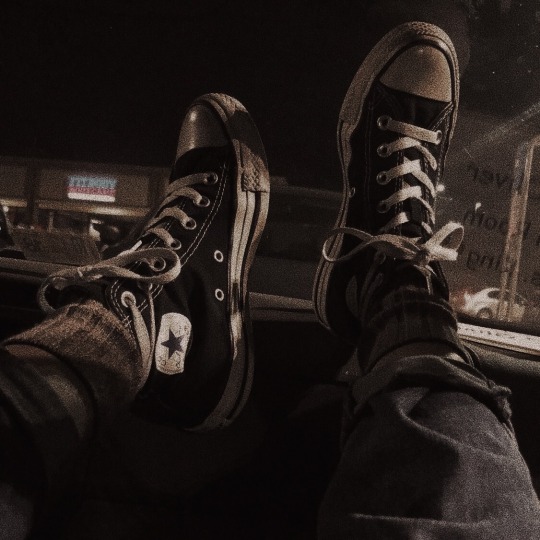
GEORGE MACKAY as grown-up MAX from WHERE THE WILD THINGS ARE
and when he came to the place where the wild things are, they roared their terrible roars and gnashed their terrible teeth and rolled their terrible eyes and showed their terrible claws, 'till Max said “BE STILL!”, and tamed with the magic trick of staring into all their yellow eyes without blinking once, and they were frightened and called him the most wild thing of all, and made him king of all wild things. "And now,” cried Max, “let the wild rumpus start!"
#very specific moodboard i made for myself and jess so if anyone else likes it thats an added bonus#i'm actually really happy w how it turned out though!!!#lowkey a serve why lie#anyway. i promise there's a method to my madness#i'm not losing it (or am i)#mine#george#wtwta#george mackay#george mackay edit#where the wild things are#where the wild things are movie#where the wild things are film#where the wild things are 2009#spike jonze#moodboard#infinite 2016#infinite short film#george mackay infinite#true history of the kelly gang#thotkg#kelly gang#kelly gang film#ned kelly#screencaps#maurice sendak#max where the wild things are#wtwta max#mood board#max records
83 notes
·
View notes
Note
In honor of music televisions 40th year what was your favorite music video growing up?
so, we didn't have cable until i was 12 and i wasn't actually allowed to watch MTV... but i did sneak it here and there, and was mystified, awed, confused, enthralled, bored, skeptical, bewitched and bewildered by TRL. i wondered why certain videos would "climb the charts" while others would barely register near the bottom. what was that alchemy? i could never figure it out. of course years later i found out that, duh, TRL didn't actually take requests, it was all based on the billboard charts, which are really based on hefty doses of payola.
i remember i really liked missy elliot and outkast videos, very colorful with great concepts. i never liked boy bands. i felt lukewarm on the female pop singers of the early 2000s, like they were fun to look at but i could never really dig the lyrics or the sound.
speaking of fun to look at, i feel like i have mentioned several times on this blog, but the lady marmalade video was a real uh. awakening
when i got older i owned the michel gondry and spike jonze DVDs (like every other young aspiring filmmaker) and i would watch those over and over. they don't all hold up. my favorites today are probably bachelorette and weapon of choice (was always a favorite; i once memorized the dance moves...) oh i just remembered star guitar, i think of that one all the time.
two more i can think of that are good that i watched a lot
https://www.youtube.com/watch?v=XKuJUxGntRI Knock on Wood
https://youtu.be/XnXiXlF7olo Dan Deacon - True Thrush
13 notes
·
View notes
Text
A24 & Annapurna: Can A Patron Of The Arts Get Paid?

Two film studios, both alike in dignity, but with wildly different trajectories. Annapurna Pictures and A24 are studios with prestigious filmographies, famous for working with auteurs - but is it profitable to be a patron of the arts?
Contents of this blog:
Annapurna? I hardly know 'er! We look at Annapurna Pictures, the Ellison family, and how Annapurna landed itself in financial strife after being the most hyped production company of the early 2010s
How do film companies make money? This is something that I've always assumed that I understand but when I actually put my mind to it, I have no idea about how a production company actually makes money. How much of the box office cash does a production company get? Or does that just go to the distributor? Let's find out!
Will A24 face a similar financial fate to Annapurna? Let's do some quick math on the ROI of A24 films and compare their business model against Annapurna
Annapurna? I hardly know 'er!
Annapurna Pictures is a film production company founded and led by Megan Ellison. Ellison is the daughter of billionaire Larry Ellison, founder and exec of tech company Oracle.
The younger Ellison got started in the film industry by using her dad's money to finance movies. In her early 20s she worked on some flops that didn't really lead anywhere financially or critically. Then, according to Vanity Fair, "in 2011, on her 25th birthday, she received from her father what a source says was $200 million... The Wrap’s Sharon Waxman has reported a figure that is more often whispered about in town: a lump sum of $2 billion." Cashed up, Ellison founded Annapurna Pictures and began to work with the talent agency Creative Artists Agency to fund films from established prestige directors.
In a 2013 profile, a female writer at Vanity Fair described Ellison as "pretty but a bit overweight" (I'm not kidding!) and "the most talked-about independent financier in Hollywood". What's interesting about Annapurna (beyond the rich daddy backstory) is the crazy run of films they've released and the number of auteurs Ellison has worked with, especially so early in her career:
Kathryn Bigelow (Detroit and Zero Dark Thirty)
Paul Thomas Anderson (The Master and Phantom Thread)
The Coen brothers (True Grit, The Ballad of Buster Scruggs)
Spike Jonze (Her)
David O Russell (American Hustle, Joy)
Barry Jenkins (If Beale Street Could Talk)
Richard Linklater (Everybody Wants Some!! and Where'd You Go, Bernadette)
Curiously, Megan's brother David Ellison also has a production company - Skydance Pictures, founded in 2006. So Larry Ellison has funded two production companies for his kids?! Skydance is less discussed than Annapurna because it tends to produce idiotbrained movies like Geostorm and The Tomorrow War so David doesn't get the same glossy write-ups in Vanity Fair.
I told my software dev bf (Matt) that Larry Ellison had personally funnelled like a billion dollars into the American film industry to make his kids happy and Matt responded 'well I'm glad he's making somebody happy because everyone hates Oracle'. Matt also provided this apparently iconic quote on the evils of Larry Ellison and Oracle.

^^^ Larry, Megan and David
The Annapurna hype was undeniable in the early 2010s because they dropped so many Oscar players from 2011 - 2014. Banger after banger. A24 is similarly hyped today but what sets A24 apart is that they tend to take chances on lesser known talent - for e.g. A24 has produced or distributed early feature films of Robert Eggers, Ari Aster, Greta Gerwig, Alex Garland, Bo Burnham, Barry Jenkins (first $1 million+ budget), Dennis Villeneuve (first English language film), and Yorgos Lanthimos (first English language film).
All of the above might sound like Ellison is an old school patron of the arts, giving away her trust fund so the Coen brothers can make more movies. But Annapurna is actually a for-profit business. The Vanity Fair profile on Ellison from 2013 discusses the balancing act Annapurna faces in funding films from Ellison's fave directors and touches on the naivety of mixing art and commerce. Quoth one source: "Megan is arrogant and thinks she can re-invent the wheel... She suffers from a chronic case of rich-itis.”
So in the early 2010s Annapurna quickly generated a lot of hype by releasing films from indie darlings and garnered substantial awards attention along the way - these were films that were typically smaller budget and turned a small profit (if any) but were critically well received and often got awards play. The problem was, in the mid-2010s, Annapurna had a run of duds: Detroit tanked. Vice tanked (reportedly losing Annapurna $15 million). Phantom Thread didn't make any money. Missing Link lost tens of millions. Of the 14 films Annapurna released between 2014 - 2018, they had one decent hit: Sausage Party, which made $140 million on a $20 million budget. Stories emerged in 2018 that Annapurna was in financial trouble. Quoth a source at the time: "I don’t care how much money daddy gives you—you have to make something turn a profit." By August 2019 Annapurna was facing bankruptcy with $200 million in debt. The company was later bailed out by Larry Ellison and is still kicking around but has been relatively quiet since then (which may also be attributable to the pandemic). For Annapurna, producing arthouse movies for critics, film school kids, and the awards crowd has not been profitable - they have required the support of a billionaire backer to kickstart the company and keep it afloat.
As I mentioned above, Annapurna seems to have a similar approach to A24. They fund indie passion projects - they're in it for the art. But Annapurna got themselves $200 million in debt by only producing art they believed in, so how does the future look for A24? Can a company like A24 can be profitable while acting as a patron of the arts - or does it require billionaire backers to keep a business afloat?
But first: let's learn a bit more about how producers get paid.
How do film companies make money?
Accounting in the entertainment industry is infamously arcane, so I'll try to keep this high level.
Who are the main players?
Producer - The organisation that bankrolls, coordinates, and is responsible for actually making the movie. These are sometimes also known as 'studios'.
Distributor - The organisation that markets the film and arranges for the film to be made available to the public via screenings in theatres, production of DVDs, etc.
In some cases, the producer and the distributor are the same company or are closely related - for example, Avengers: Endgame was produced by Marvel Studios and distributed by Walt Disney Studios Motion Pictures which are both subsidiaries of The Walt Disney Company.
Where can money be made?
Movies can make money via theatre box office, streaming syndication, BluRay steel box sales, merchandise, etc. But the primary avenue and quickest return is box office - this is the metric that is typically used to determine whether a film has been a success or not.
How do distributors and producers work together?
This is all subject to individual agreements and may change from film to film, but in general there are two forms of agreement that a distributor might make with a production studio:
Profit sharing: the distributor and the production company split the downstream profits of the film. For example, the distributor may have a gross points arrangement with the producer.
Leasing: the distributor pays a fee to acquire the rights to distribute the film - profits made will largely be kept by the distributor (although there may also be a gross points arrangement). When Netflix has exclusive distribution rights for a film, we could safely assume that they are using some form of leasing agreement with the production studio because (1) films released on Netflix tend not to make much at the box office and (2) it's difficult to extrapolate profitability from Netflix's viewership and subscription numbers (although I'm sure they have methods of roughly approximating this).
It's something of a gamble for producers in terms of which arrangement is likely to be of the greatest benefit to them. You may be able to lease a film to a distributor for a modest profit and call it a day or you can gamble on seeking a cut of downstream profits, but audiences are fickle and these profits may never materialise.
As an example...
For any given film, it's difficult for an outsider to know what form of distribution arrangement the film had and therefore how to calculate whether the film would have made or lost money for the producer and distributor. In the end, for a film to be profitable, a film needs to make more in sales than it cost to produce and market. There are some rule of thumb calculations we can use to roughly calculate overall profitability and to determine whether the film was a win or a loss for the studio and distributor.
Let's look at an example to determine roughly whether it was profitable or not. Note: box office and budget info on Wikipedia can be inaccurate but let's just go with it. All of the following figures are in US dollars. Wikipedia puts Dunkirk's production budget at $100 - $150 million. Let's split the diff and say $125 million. According to Forbes, the marketing budget was $135 million. So $260 million in up front costs. Dunkirk made $527 million at the box office. As a rough rule of thumb, 50% of box office profits are kept by the theatre - this may vary based on deals, distributor, and even country but let's just go with 50%. So assuming the theatres took 50% of that $527 million, about $263 million might make it back to the studio and distributor. Subtracting the $260 million for production and marketing, this would give them only $3 million in clear profit. The film then would go on to make more through digital sales and rentals, streaming, etc.
So after production and marketing costs, a film needs to more than double its budget in box office takings to begin to see a profit. To keep making movies, studios need to do more than cover their expenses - they need to make a profit to be able to pay dividends to investors and fund future projects.
What's to stop A24 facing a similar financial fate to Annapurna?
As I've mentioned, A24 and Annapurna play in the same sandpit: they primarily work on movies that the studio considers art, there are no cynical cash grabs in their filmographies. I'm curious if A24 is in a similar financial position to Annapurna - and if not, why not?
So let's do some high level accounting with A24's filmography to see if their films generally make or lose money. I'm making the following assumptions:
Only looking at box office takings (because I just know I'm never gonna find details on the DVD sales of films like First Reformed)
Movie theatres keep 50% of box office takings
Marketing budget is 10% of production budget. It's difficult to say how much is actually spent on marketing for these kind of indie films (and it's not information that is available online) so I'm being conservative - for basically any of these films that you've actually heard of, I'd assume the marketing budget was significantly more than 10%
I'm only looking at films released up to the end of 2021 so they've had a decent stretch in theatres.
In this Google sheet, I've charted the budget, guesstimated marketing costs, box office, and a rough profit/loss based on those figures. For lots of movies, the budget wasn't available so I've excluded these from the final total - these were typically movies I've never heard of so I'd assume they weren't big money makers. Of the 60 films where I was able to calculate profit/loss, 26 were profitable at the box office. Of the 50-ish other films where I couldn't calculate profitability (because I couldn't find enough data) only a few look like they might have been profitable - e.g. The Killing of a Sacred Deer, Lamb, The Children Act. Overall it looks like A24 is running a significant loss on their films based on box office takings. I've arrived at A24 taking a $32 million loss but this is really just indicative based on my assumptions above and very rough calculations. Still, I think this is finger-in-the-air accurate and the finger points to A24 movies not recouping their costs at the box office. There is then streaming, DVD sales, etc. but the box office is generally a good indicator of public interest: a box office bomb is unlikely to perform much better via digital rentals.
As a disclaimer, obviously the pandemic has fucked up two years of releases so I'm sure every studio has had a rough run since Feb 2020. Before the pandemic, A24 had some big hits (Lady Bird, Hereditary, Midsommar, The Farewell) that probably worked well to cover their loses on other films. But since 2019, A24 has only had one film that turned a profit at the box office: Minari, which looks like it would have made at least $5 million profit. A24 didn't produce Minari so it's hard to say what portion of those profits they would actually have received.
From my digging, it looks like A24 has worked under both profit sharing and leasing agreements. This court case reveals a bit about the distribution deal for A24's second ever release, Spring Breakers - which was actually a film produced by Annapurna. Annapurna engaged A24 as the distribution partner for Spring Breakers, and the suit tells us that:
This was a profit sharing arrangement with A24 receiving 20% of profits
While A24 arranged the marketing, the marketing costs were actually covered by another party (Annapurna?)
The esteemed Mr. Harvey Weinstein (and the Weinstein Company) had offered to purchase the rights to the film (under a leasing agreement) for $2.25 million
Then this oral history describes A24 going on a 'spending spree' in their second year of operation (2014) and refers to them purchasing movie rights, so I'm assuming A24 had leasing arrangements - presumably funded off the back of their Spring Breakers success. This means A24 would largely bear the brunt of financial losses on these films as they paid out of pocket to acquire the film and then paid for the marketing. Of course, A24 also has TV deals (e.g. Euphoria with HBO) and, thanks to their popularity, also sell merch, but on paper they don't appear to be slam dunk profitable.
It's interesting to note that A24 initially started out exclusively as distributors and have moved increasingly into the production game. This is the opposite path taken by Annapurna which worked solely in production for years and then launched a distribution division in early 2017. When Annapurna faced bankruptcy in 2019, Indiewire noted: "The company’s financial woes began in full after it decided to start its own distribution arm to release its productions, beginning with Kathryn Bigelow’s “Detroit.” Since then, nearly every Annapurna release has been a box office bomb for the studio. Variety reported in March [2019] that only one movie has turned a profit for Annapurna since it launched a distribution arm: Boots Riley’s “Sorry to Bother You.”
Another point of difference with Annapurna is that the three founders of A24 all had experience in film production and financing before they founded the company. In fact, 'twas founder Daniel Katz' former employer Guggenheim Partners that provided "a few million in seed money" to start A24. This Hollywood Reporter article from 2014 actually says that A24 is owned by Guggenheim Partners. As of 2018, Guggenheim had sold their stake to MRC which is owned by Eldridge Industries, a holding company with a net worth in the billions. Cute arthouse film company you've got there... sure would be a shame if it was owned by a billion dollar investment firm, sure would be a shame if your sweet little indie cinema business was sold around town, passed from one LLC to the next like any other asset. Indie really doesn't exist.
So A24 actually has a billionaire backer too - apparently MRC/Eldridge only has a 'minority stake' in A24 but whatever ("I own 49% of this company!"). A24 also appears to rely on bank loans to operate, so at some point it has to turn a profit. Larry Ellison will keep pumping money into Annapurna because he loves his daughter - but cold hearted industry guys in Hollywood board rooms wouldn't bail out A24 unless there was something in it for them.
Remember what those snarky industry sources said about Megan Ellison: "I don’t care how much money daddy gives you—you have to make something turn a profit." No one seems to talk this way about A24 but on paper they don't seem to be doing that much better financially. But despite how it looks, A24 must be doing okay: the explored acquisition in 2021 with a reported price of $2.5 - $3 billion - supposedly Apple was interested. And then in early March 2022, A24 announced a $225 million equity deal - this amount apparently bought the investors less than a 10% stake in the company so A24's valuation is still sitting at $2.5 billion (ish).
So why is A24 valued in the billions while Annapurna nearly went bankrupt? Without actually seeing their accounts, it's difficult to say - spitballing some ideas:
Sources indicated that Megan Ellison and Annapurna were perhaps not prudent in how they spent money on film production. Blowing out the production budget makes it harder to recoup costs
A24 may be particularly canny in how they strike deals and run their operation meaning the business covers its costs or turns a profit even if the film they're releasing isn't profitable
A24 was founded by industry veterans using investor money whereas Annapurna was founded by a wealthy outsider using her own (father's) money. Having skin in the game (i.e. no trust fund) and pushy investors may be a more powerful motivation to turn a profit
Annapurna launched Annapurna Interactive in 2016 as a video game publisher. Annapurna Pictures never attracted the kind of rabid fandom that A24 did, but Annapurna Interactive is very popular with gamers so this venture appears to have been a success... but maybe video game publishing has actually been a drain on business funds which contributed to the bankruptcy?
A24 and Annapurna appear to be working on similar types of films, but Annapurna films typically have a much higher budget. Annapurna budgets appear to typically be $30-40 million. A24 budgets are generally smaller - more like $10 million. Losing money on a $2 million movie like First Cow is a lot less damaging than losing money on a $30 million movie like Detroit
The movies where A24 has dipped their toe into production as well as distribution typically seem to turn a decent profit (Uncut Gems, Midsommar, Mid90s) which may keep things rolling and increase interest in A24 as a production joint
I think this is the most likely explanation: the A24 brand is very valuable - maybe not worth billions but certainly worth something even if the business itself is not wildly profitable. People get excited about a movie because A24 is distributing it - A24 has such good taste that their decision to work on a film is a marketing point. Such is the hype around A24 that they could probably create their own streaming platform and compete with the Criterion Channel and maybe even HBO? This kind of reputation would certainly play a part in a valuation when a company like Apple begins sniffing around - A24 will confer a lot of credibility to any entertainment business that acquires them. As to why Annapurna has missed out on this juice? It may just be a marketing issue
Further reading: a likely bogus copy of A24's 2019 annual report is available online. I haven't included this in any of my calculations above because I don't trust the financials in this report - the income column in the theatrical releases table (numbered page 8/PDF page 12) includes dummy figures. The report is hosted on a graphic designer's website and I suspect is available only as an example of her work with the actual financial figures redacted. This would explain why the figures in the report don't make sense (why would net income be higher than gross?) but that may also just be my reading of it. It's still an interesting read if only to see a template A24 may have used for this kind of reporting
4 notes
·
View notes
Text

Book of the month / 2021 / 04 April
I love books. Even though I hardly read any. Because my library is more like a collection of tomes, coffee-table books, limited editions... in short: books in which not "only" the content counts, but also the editorial performance, the presentation, the curating of the topic - the book as a total work of art itself.
björk :archives. A retrospective
Klaus Biesenbach
Monograph / 2015 / Schirmer/Mosel Publishing House
Iceland, the land of geysers, the largest volcanic island on the planet. Home of the Icelandic pony with its exclusive gait of the tölt and the most active literary community in the world. Soccer mecca and most sparsely populated country in Europe. Icelandic names - for example the highest mountain Hvannadalshnúkur - are hardly pronounceable, although the alphabet does not even know many common letters such as C, W, Q and Z. There is a separate holiday for seafarers and a division of time into 3-hour periods starting at midnight. 16 German cities each have more inhabitants than all of Iceland, which has therefore its own dating app to prevent relatives who are biologically too close from mating. It's a fascinating country.
Given the size of the country, it's probably no wonder that Iceland's pop cultural influence internationally is rather limited. Despite the Nobel Prize for Literature winner Halldór Laxness, whose work I don't know, and the crime series The Valhalla Murderers, which I know thanks to Netflix. But wait - wasn't there something else? Yes, that's right, Iceland has a globally successful Gesamtkunstwerk named Björk. Her contributions to music, video, film, fashion and art have influenced a generation worldwide.
Björk Guðmundsdóttir, born in Reykjavík in 1965, has made a name for herself as a singer, music producer, composer, songwriter and actress with a broad interest in different types of music, including pop music, electronic music, trip-hop, alternative rock, jazz, folk music and classical music. To date, she has sold over 20 million albums worldwide. Certainly not only because of the seemingly endless variability of her compositions, but also because of her voice, which one can confidently call unmistakable. She causes goose bumps, whether you like her music or not.
Little Björk attended music school at the age of five and was taught singing, piano and flute, among other things, for ten years. One of the teachers sent a recording of her singing the song "I Love To Love" by Tina Charles to a radio station. The broadcast was heard and liked by an employee of the Icelandic record publisher Fálkinn and subsequently offered her a recording contract - when she was eleven years old. With the help of her stepfather, who played guitar, she recorded her first album. It contained various Icelandic children's songs and cover versions of popular titles, such as "Fool on the Hill" by the Beatles. The album became a great national success.
At 14, Björk formed the girl punk group Spit and Snot, the maximum contrast program to the children's songs. This was followed by the fusion jazz group Exodus, later Tappi Tíkarrass and Kukl (Icelandic for witchcraft), with whom she developed her signature vocal style. First foreign tours to England and West Berlin followed. Then in 1986 came the formation of the band Pukl, later renamed The Sugarcubes. The first single brought respectable success in England and USA, The Sugarcubes reached cult status. The first record deal with Elektra Records led to the album "Life's too good" in 1988, making them the first Icelandic band ever to become world famous.
The transformation into a total work of art began in 1992 at the latest with Björk's move to London. The first solo album, appropriately named "Debut," became the album of the year according to New Musical Express. Now even Madonna wanted to have a whole album written by Björk, but it remained with the title track "Bedtime Story", she remained true to herself and her love of experimentation. The New York based news magazine "Time" named her the "high priestess of art" and in 2015 put her on the list of the 100 most influential people on earth. She rounded off her visual extravaganza, that even her wardrobe was prominently featured in the major retrospective at New York's Museum of Modern Art (MoMA).
Schirmer/Mosel Verlag is an art book publisher in Munich founded in 1974 by Lothar Schirmer and the commercial artist Erik Mosel. Schirmer became friends with artists such as Cy Twombly and Joseph Beuys at a young age and began collecting their works. By buying and reselling art prints and drawings, he earned the start-up capital for his publishing house. With his publishing debut, he ensured the rediscovery of August Sander, a visual artist of the Weimar Republic. There were various publishing collaborations with the MoMA, and in 2015 there was also the retrospective mentioned above. And of course, in keeping with the protagonist, the publication had to become a work of art itself.
"björk :archives" comes in an elegant slipcase containing six parts: four booklets, a paperback and a folded catalogue raisonné poster with the covers of all Björk albums. A closer look is worthwhile: first there is a thematic introduction by the editor and exhibition curator at the MoMA, Klaus Biesenbach. Then an illustrated essay by Alex Ross, music critic of the New Yorker, which deals with Björk's creative dissolution of musical and aesthetic boundaries. Another by Nicola Dibben, professor of musicology at the University of Sheffield, on Björk's creativity and collaborations. And the collected e-mail correspondence similar to a pen pal relationship between Björk and American publicist, philosopher and literary scholar Timothy Morton.
The book itself, the centerpiece of the edition, is about Björk's seven major albums and the characters she created for them. Poetic texts by Icelandic author Sjón, with whom Björk has long collaborated, are joined by a veritable treasure trove of illustrations: Photos of live performances, stills from the music videos of masters like Michel Gondry or Spike Jonze, Björk in stunning costumes by designers like Hussein Chalayan or Alexander McQueen, and PR shots by star photographers like the duo Inez van Lamsweerde & Vinoodh Matadin or provocateur Araki.
The design of the publication quotes music scores and comes from the renowned Parisian design studio M/M. It all adds up to an extraordinary visual masterpiece, a tribute to the magical world of Björk. And that at an hardly believable price of € 19.80. A reviewer on Amazon (no, you shouldn't shop there - support local businesses!) sums it up: "This is a collection of art, stories and references very well organized and assembled with care. The price does absolutely not represent how valuable this product is, I am positively surprised." Positively surprising - that could truly be Björk's mission statement.
Björk's music itself is so rich in pictorial statements that it doesn't really need any exuberantly creative videos to go with it. Therefore, according to Slant Magazine, her best video is her first, relatively simple one: "Big Time sensuality" from her "Debut" album purely shows her joy in music. Here's the link:
https://youtu.be/-wYmq2Vz5yM
youtube
#book#book review#björk guðmundsdóttir#björk#the sugarcubes#iceland#schirmer Mosel#MoMA#museum of modern art#new york city#retrospective#Klaus biesenbach#gesamtkunstwerk#Voice#cult#singer songwriter#music#Reykjavik#Youtube
20 notes
·
View notes
Text
Ranking : Jim Jarmusch (1953 - present)
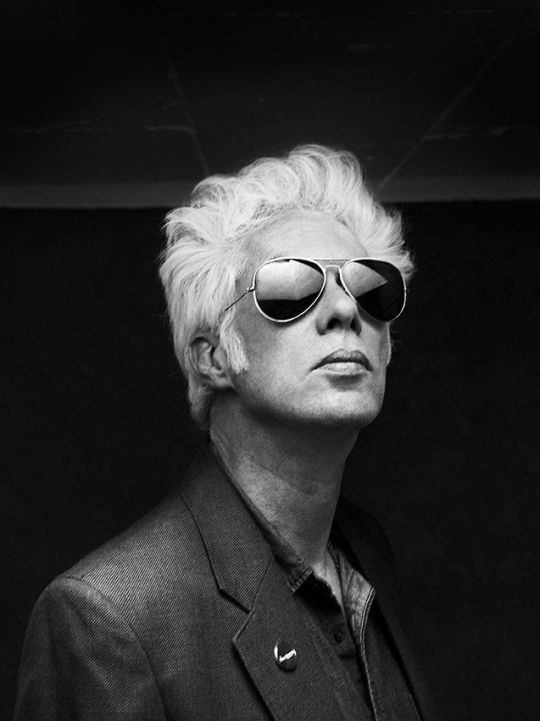
When you get someone adept at the art of filmmaking that can resonate at the highest vibrations when creating, that is a blessing in itself, but when you get a jack of all trades, everyman who is deeply observant and unabashedly humanist, and happens to make films to boot, then you start reaching the realms of Jim Jarmusch. As a Midwestern kid who studied at New York’s famed Columbia University before transitioning to a span in Paris, Jarmusch has the unique gift of deeply appreciating lofty art on the same level as outsider, underground art, and by understanding the context that connects all of them, his appreciation of time is enhanced by association. In a world that has become obsessed with taking in information with no intention of retention at a breakneck speed, it is refreshing to know that Jim Jarmusch has stood his ground in terms of deliberate pacing and tone.
Most of my Jarmusch familiarity came from the first half of his catalog, and it’d been years since I watched his work, so rather than rank what I remembered while trying to fit first watches in, I decided that the time was right to revisit the entire catalog. Doing so not only gave me a broader understanding of his overall vision, but it made me realize that a director with 25 years in the game is still capable of making drastic style shifts. Without further ado, here is my preferential ranking of the 13 Jim Jarmusch films available as of March 2021.

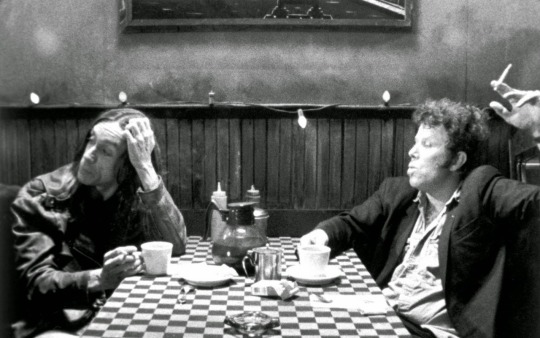
13. Coffee and Cigarettes (2003)
This isn’t a bad film, but Coffee and Cigarettes definitely reeks of a narrative-less venture. The best parts of Coffee and Cigarettes come in attempts at placing what was shot explicitly for the film, versus what was shot during the previous fifteen or so years that Jim Jarmusch directed other feature films. Taken as a collection of independent vignettes, the film is rich in memorable moments, but for a director so adept at unifying themes with incredible nuance, specifically within the obtuse hurdles presented by an anthology film, Coffee and Cigarettes feels much more like assorted pieces than a fractured whole. More so than an original idea, the movie feels like a deep cut that true fans will appreciate, casual fans can easily reference, and Jarmusch-laymen can use as an entry into deeper conversations. If nothing else, see Coffee and Cigarettes for the incredibly entertaining scene where Cate Blanchett acts circles around Cate Blanchett, but Cate Blanchett still does her thing.

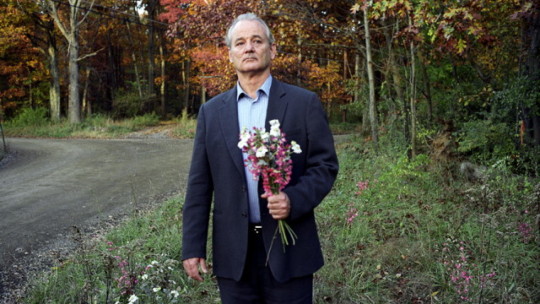
12. Broken Flowers (2005)
Bill Murray has been popular longer than I’ve been alive, but somewhere around the beginning of the 21st century, it seemed like the entire world caught Bill Murray fever in a major way. After a couple of iconic roles in films by Wes Anderson and Spike Jonze, his star was riding new and unfathomable highs, and that was right when Jim Jarmusch teased collaboration via Coffee and Cigarettes before diving headlong into it with Broken Flowers. Of all the Jim Jarmusch films, this one still feels the least like his style, at least in terms of purity. Most of its magic comes from surrounding Bill Murray with Jeffrey Wright as a human conscience, as well as a parade of memorable actresses the likes of Sharon Stone, Frances Conroy, Jessica Lange, TIlda Swinton, Chloë Sevigny and more. The film runs high on charm, and for any man staring at the Autumn of his years, the feelings of romantic regrets are likely relatable on some level. Interestingly, this project feels like one of the most accessible in the Jarmusch canon, perhaps because of its efficient production presentation. If there were ever a Jim Jarmusch date movie, it’s Broken Flowers.

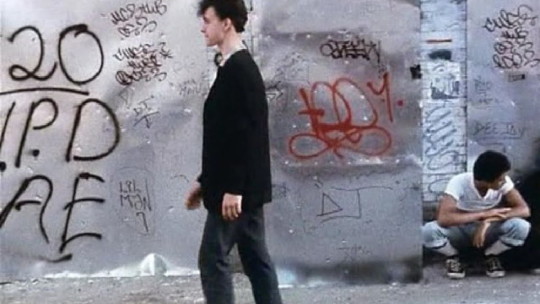
11. Permanent Vacation (1980)
Upon initial viewing, Permanent Vacation possesses many of the earmarks of a student film, such as limited locations, long passages with minimal dialogue, symbolic monologues in place of standard narrative dialogue, and isolated characters within the context of an implied bigger world. The strengths that the film possesses, however, are elements that became staples in Jim Jarmusch films : a protagonist either absent of motivation or driven from within, cross-cultural fascination and iconography and the aforementioned patient approach to narrative are some of the key ingredients in the Jarmusch recipe. As a unique voice in a burgeoning New York collective of filmmakers, it makes total sense that his debut would be both an ode to New York City and an ode to living life like an outsider in the mecca of culture. This film probably wouldn’t be the best place to start a curious party to the Jim Jarmusch canon, but it would certainly be one to circle back to if their interest is piqued… I would recommend this one to fans of Richard Linklater’s early work for sure.

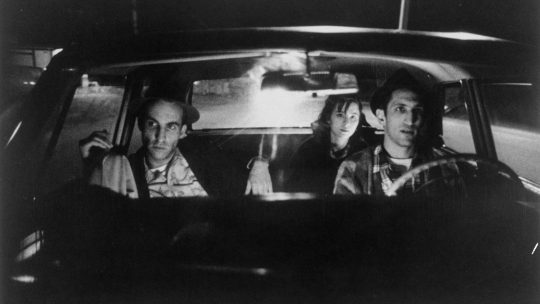
10. Stranger Than Paradise (1984)
Stranger Than Paradise marks the first of many black and white commercial releases from Jim Jarmusch. As a second film, it has everything you’d want to see from a director finding his place in the industry : the cinematography has evolved and incorporated more movement, Jarmusch is starting to let his personality shine through via musical choices, and the stories are evolving into more relatable narratives rather than ruminations on isolation (while simultaneously becoming much funnier). Jarmusch still isn’t afraid to let his films breathe, however, which leaves his distinct style present even among the areas of growth. The incorporation of a strong female lead presence (thanks to Eszter Balint’s brilliant performance) showed that Jarmusch had a full understanding when it came to presenting stories for everyone on the screen, rather than limiting his voice to male characters. The casting of John Lurie and Richard Edson opposite one another is kinetic both visually and in terms of performance, as each of their versions of uptight laid-backness compliment one another.

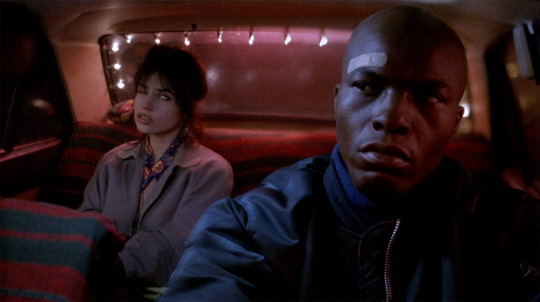
9. Night on Earth (1991)
Of the anthology films that Jim Jarmusch has created, Night on Earth is possibly my favorite. More so than any of the others, it captures the intriguing aspects of human nature by juxtaposing them directly against the very human tendency to judge books by their covers. With the vast majority of the film taking place in a handful of taxi cabs, we are left in the hands of the actors and actresses in the hopes that their interactions, chemistry and dialogues can keep us captivated, and the cast presented in the film completely stand up to the challenge in their pairings. Jarmusch also presents movie audiences with a way to show different worldly locations without having to lean on the cinematic and iconic shorthand that we are used to, such as the Hollywood sign, Times Square, the Eiffel Tower and so on… instead, we are shown places that locals would inhabit in all of their rundown and lived in glory, which in turn, amplifies the grounded realness of the interactions, as if we are looking at a fictional blueprint for what would later become the popular HBO series Taxicab Confessions. This film sits in-between two of Jim Jarmusch’s most iconic releases, so it is easy to see how this one could be easily lost in the shuffle, but it is certainly not a film to be missed, especially for those who would consider themselves Jarmusch fans.


8. Paterson (2016)
Jim Jarmusch brings a humble sense of humanity to all of his films, but Paterson stands out for its nuance, subtlety and confidence in its patience. Much like Forrest Gump or a less abstract Charlie Kaufman film, Paterson dwells in an interesting realm of an unknowingly wise protagonist tethered to the center of tornado-like emotions and experiences from all they encounter. Jarmusch manages to take this framework, dial down the absurdity to a sneaky degree, and ramp up the grounded elements to the point where a viewer cannot help but graft pieces of themselves onto the events presented. As a musician with a day job, I can also relate to Paterson’s displays of beauty found in redundancy, and the peace that comes with understanding intentions for creative expression, even if others see it in a different light that you do. While not the grandest of Jim Jarmusch gestures, it is without a doubt one of the most sincere and heartfelt of his selections.

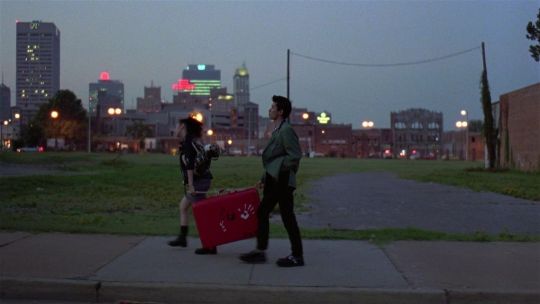
7. Mystery Train (1989)
Mystery Train marks the first definitive signs of Jim Jarmusch knowing, understanding and utilizing the tools he’d come to favor in a manner that seemingly resonated what he pictured in his head. Memphis as a setting provides the juxtaposition of beauty and urban decay captured in Permanent Vacation; placing our audience on a journey with two foreign tourists brings the worldly view introduced in Stranger Than Paradise; and, most importantly, all of the coolness and humor that thrived in Down by Law returns triumphantly. Jarmusch also puts anthology filmmaking on the table, which is important for two reasons… first and foremost, it would become a style he would go on to thrive in, returning to it immediately with Night on Earth and once more with Coffee and Cigarrettes… secondly, as for Mystery Train directly, it allowed Jarmusch to surround Masatoshi Nagase and Youki Kudoh (burgeoning stars Western audiences were unfamiliar with) and Nicoletta Braschi, and surround them with his talented friends like Steve Buscemi, Cinqué Lee, Rick Aviles, Vondie Curtis-Hall and Tom Noonan, as well as legendary musicians like Tom Waits, Joe Strummer, Screamin’ Jay Hawkins and Rufus Thomas. Between these high profile castings, the stylish cinematography and the heartfelt quirkiness of the leads, Mystery Train feels like the film where everything came together in the best ways possible.


6. Down by Law (1986)
To my knowledge, Down by Law would be considered the breakout success of the Jim Jarmusch library. John Lurie returned to the fold to provide another performance infused with coolness, but this time around, up and coming Italian star Roberto Benigni and iconic recording artist turned actor Tom Waits share lead duties, forming an unlikely trio with monstrously dynamic on-screen chemistry. Jarmusch not only switched things up for himself by setting the film in New Orleans rather than centering it around New York, but he turned the jailbreak genre on its ear by focusing on the escapees rather than the escape itself. The conflict between Jack and Zack is seeded with their individual problems with women (which both include emasculating each man by chastising them for not using domestic violence), as well as each of them ending up framed prior to imprisonment, which makes Roberto the de facto peacemaker despite his huge language barrier. Down by Law marks the first time that edginess found its way into a Jim Jarmusch film, and while it never became his forte, it wasn’t the last time that element was key to a Jarmusch film.

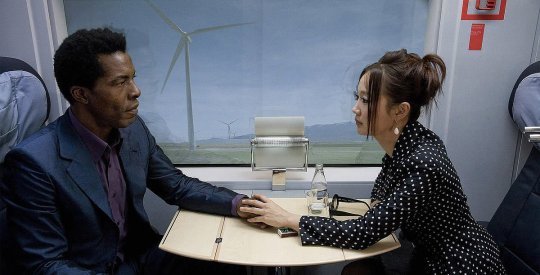
5. The Limits of Control (2009)
When reflecting on The Limits of Control, the word patience comes to mind : the patience of accepting repetition… the patience of a trilingual film with minimal dialogue… the patience of a film that shows much more than it tells. As a take on noir, the Jim Jarmusch variety brings to mind films like Le Samourai, where actions speak infinitely louder than words, choices come with a definitive set of consequences, and we as viewers are allowed to consider what we are presented with in real time, just like our protagonist. The coolness levels are also pushed to maximum levels in this film, but then, what’s a Jim Jarmusch film without a generous dose of cool in it? While it is never rightly stated, I like to pretend that The Limits of Control takes place in the same universe as Ghost Dog, with Raymond having evolved into The Lone Man using the tools left behind by Ghost Dog. Maybe it’s a bit of embellishment on my end, but it makes an already great film have that little extra touch of pizazz needed to stand out from the pack.


4. Ghost Dog: The Way of the Samurai (1999)
While Jim Jarmusch isn’t necessarily a household name, he is relatively well known, and for many familiar with his work, Ghost Dog: The Way of the Samurai served as the introductory film for them. The casting of Forest Whitaker in the lead role continued the trend of higher profile names joining the Jarmusch fold, and stylistically, the mixture of Ghost Dog’s hitman and samurai worlds with that of the mafia film (which was about to see a popularity resurgence in light of the recent premier of The Sopranos) was alive, kinetic, and rich with varied personalities. Ghost Dog: The Way of the Samurai also stood as an early example of RZA’s talents in the realm of scoring films, which would later go on to be a key element of Kill Bill: Vol. 1. For a movie with a more traditional approach, perhaps even the most accessible approach of all Jarmusch films, Ghost Dog: The Way of the Samurai is anything but conventional, and it’s the sense of pride it wears in its non-conventionality that makes it the cult classic it became.

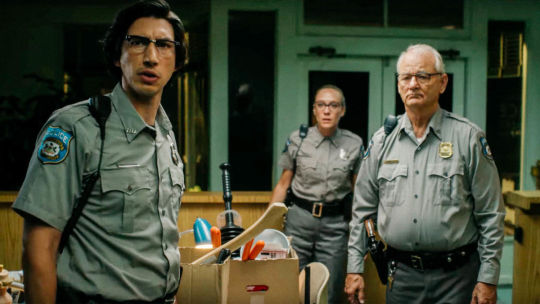
3. The Dead Don't Die (2019)
Not since Dead Man has Jim Jarmusch picked such a distinct genre for a film of his, or decided to include such a long list of high profile names in character roles. While the sense of doom that usually comes with zombie movies is present, Jarmusch sticks to his toolkit by focusing solidly on the human element during the early portions of the film where many people would already have zombies doing the narrative and visual heavy lifting, and in turn, the audience finds themselves drawn deeper and deeper into the story well before the undead arrive. Of all the Jarmusch films, The Dead Don’t Die has the rare designation of being the only one that seems to comment on film itself, be it references to iconic characters from other properties, ruminations on film as a format, or even discussions centered around film fandom. While most films tend to stay around from outright explanations of whatever the root cause of the zombies are, The Dead Don’t Die uses the vacuum as a brief opportunity to make a comment on polar fracking and other climate/environment-altering processes. Even the zombies get the most on-screen humanity received since the days of George Romero’s Dead series, a refreshing change of pace that has been often ignored in recent films centered around the undead. Films like this one prove that Jim Jarmusch has the capacity to make films about most anything, and the further he strays from his supposed comfort zone, the seemingly better the films get.

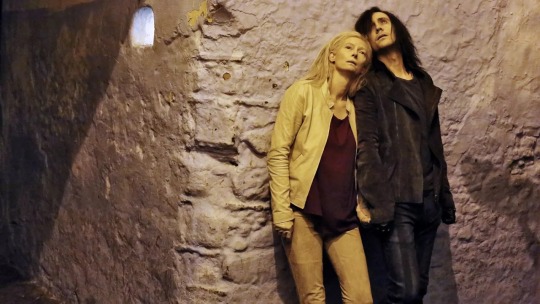
2. Only Lovers Left Alive (2013)
For a man so dedicated to being aware of the passage of time, a man with a deep appreciation for nostalgic cool of all eras, and a man with a rich and layered appreciation for art and music from across the board, it makes total sense that Only Lovers Left Alive would be a celebration of all these aspects framed as an eternal love with a deep cross-section between the original lovers and the tales of vampires. The vampiric leads allow Jarmusch the perfect vehicle to seamlessly tie stellar creativity from any point in time with a singular line, and the deep implications of our protagonists' names suggest a subtextual lore that one could likely build a cinematic universe around. For a venture with aspirations this lofty, the casting must fit the call, and the main four of Tilda Swinton, Tom Hiddleston, John Hurt and Jeffrey Wright build a solid foundational square for all characters to navigate deep emotions freely. If you’re looking for Twilight and Interview with the Vampire fare, you’ll probably long for more, but if films like Let the Right One In are more your speed, then Only Lovers Left Alive will likely be a revelation.


1. Dead Man (1995)
While Jim Jarmusch never lost his auteur sensibilities, Dead Man marked his initial foray into the world of larger scale traditional productions through the vehicle of the period piece. Jarmusch films were not unfamiliar with showing us a broader view of the world we know, but transposing his trademark style into the world of the Western marked a bold (but ultimately rewarding) turn. With Neil Young serving as his Ennio Morricone, Jarmusch dusted off his black and white filmmaking equipment and seemingly told the production design team to blend all of the best parts of Spaghetti Western and German Expressionism. Johnny Depp, the film’s star, was riding the wave of success afforded from What’s Eating Gilbert Grape?, Benny & Joon and Ed Wood, and Dead Man carried that momentum right along. As for his Western universe, the list of names that Jarmusch chose to populate it with is where his style stood out : Crispin Glover, John Hurt, Robert Mitchum, Iggy Pop, Gibby Haines, Gabrielle Byrne, Billy Bob Thornton, Alfred Molina and more drive home Depp’s “fish out of water” characterization convincingly. Based on its period-piece designation, Dead Man signalled a drastic leap in style utilization for Jarmusch, a creative rarified air that he would return to for several future productions.
#ChiefDoomsday#doomonfilm#JimJarmusch#PermanentVacation#StrangerThanParadise#DownByLaw#MysteryTrain#NightOnEarth#DeadMan#GhostDogTheWayOfTheSamurai#CoffeeAndCigarettes#BrokenFlowers#TheLimitsOfControl#OnlyLoversLeftAlive#Paterson#TheDeadDon'tDie
14 notes
·
View notes